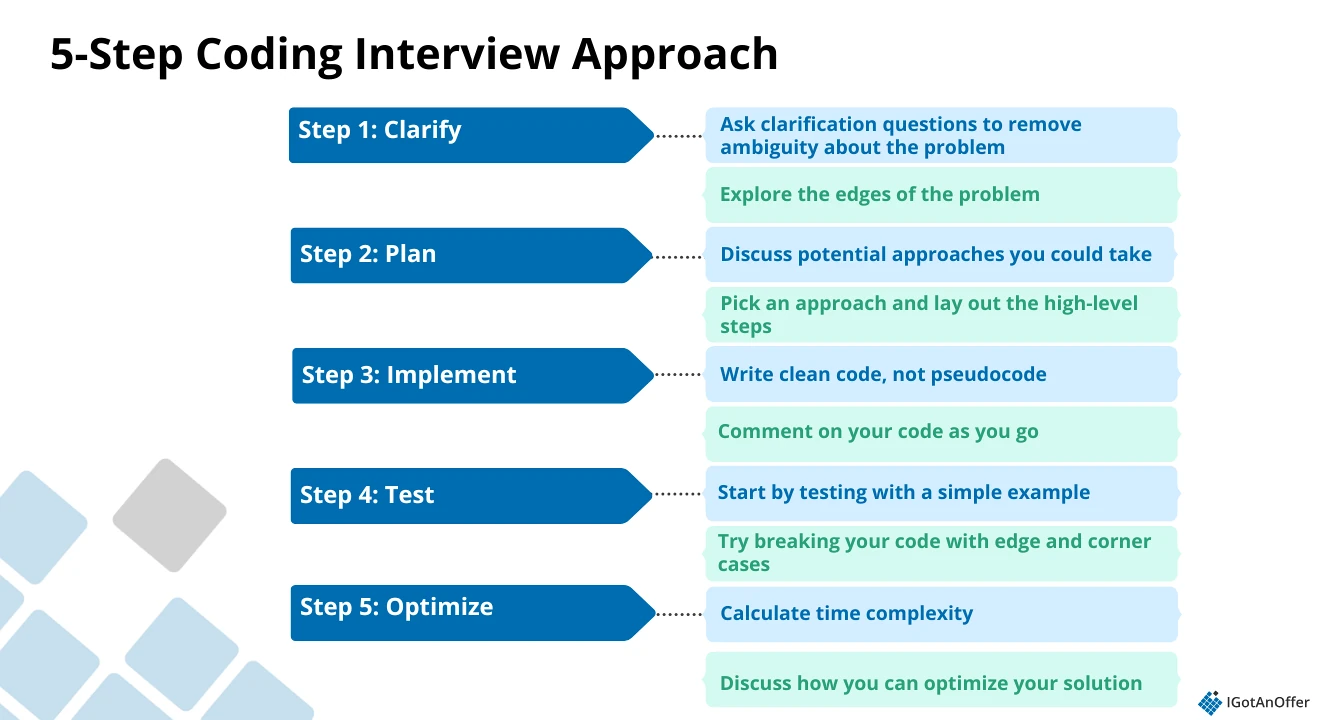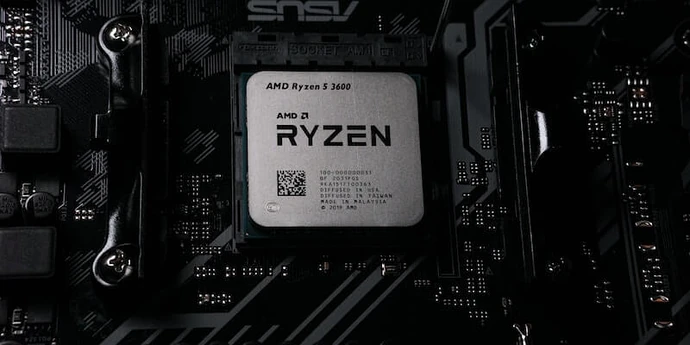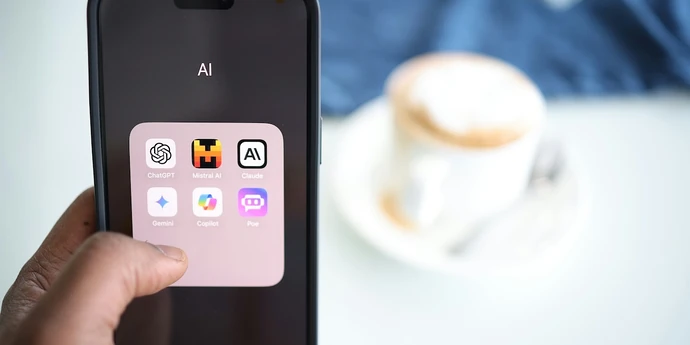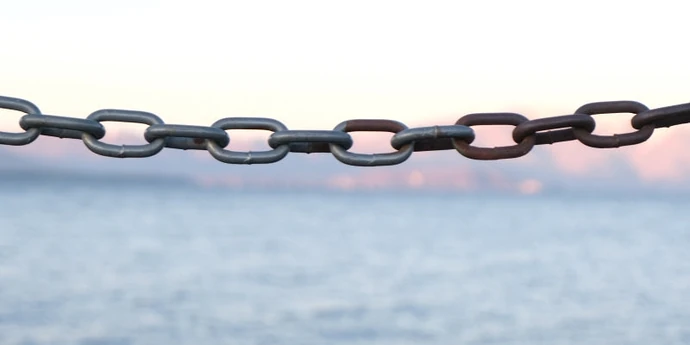We’ve helped thousands of candidates ace their coding interviews at top tech companies, and one thing is clear: preparation is everything.
Practicing coding problems is important, but it’s only one part of your prep strategy. Big Tech interviews test far more than your ability to solve algorithm questions.
Below, we outline the five essential steps to prepare effectively and maximize your chances of landing an offer at Google, Meta, Amazon, or any other FAANG+ company.
- Own the process
- Refresh on data structures and algorithms
- Learn a consistent answer method
- Practice solving example questions
- Improve your coding interview skills
Let’s go!
Click here to practice coding interviews with experts
1. Own the process↑
Before you get down to the nitty-gritty of coding practice, it’s worth doing some quick reading to understand what kind of hoops you’ll be jumping through.
1.1 What is a coding interview like?
Coding interviews at FAANG and other top tech companies tend to last around 40-45 minutes.
You'll probably be asked to code in a specific app that the company uses for coding interviews. If it's an in-person interview, you'll be given a laptop to do this on. It's now quite rare for candidates to have to write code on a whiteboard.
While a big part of your prep will involve solving Leetcode-type problems, your coding interview will be different. Aside from your problem-solving skills, you’ll also be assessed on your communication and collaboration skills. So instead of just quietly solving coding problems, you’ll be expected to talk through your thought process and collaborate with your interviewer.
You can also expect “trivia” type questions that test your knowledge about an area of coding, rather than asking you to solve a problem. These are most common in the early rounds, as the recruiter or hiring manager tries to get a sense of your level of expertise.
As well as coding problems and questions, you may face behavioral or cultural fit questions at the beginning or end of a coding interview.
1.2 How many coding interviews will I face?
The number of coding interviews you might get depends on the role and company you’re interviewing for. For instance:
- Software engineers: 1 or 2 technical screens involving coding questions as part of the early rounds, 3 coding interviews at the onsite stage
- Data scientists: usually just 1 coding interview at the onsite stage
- Engineering managers: usually just 1 coding interview or code review at the onsite stage, more focused on system design interviews.
Refer to our specific guides for each role and tech company to get the exact breakdown of what you can expect from the interview process, including the exact number of interviews and what type of questions you can expect in each:
- Meta software engineer interview guide
- Meta engineering manager interview guide
- Meta technical program manager interview guide
- Meta machine learning engineer interview guide
- Meta data engineer interview guide
- Meta production engineer interview guide
- Meta research engineer interview guide
- Google software engineer interview guide
- Google engineering manager interview guide
- Google technical program manager interview guide
- Google site reliability engineer interview guide
- Google data engineer interview guide
- Google machine learning engineer interview guide
- Amazon software development engineer interview guide
- Amazon software development manager interview guide
- Amazon technical program manager interview guide
- Amazon data engineer interview guide
- Amazon machine learning engineer interview guide
- Microsoft software engineer interview guide
- Microsoft engineering manager interview guide
- LinkedIn software engineer interview guide
- Airbnb software engineer interview guide
- Uber engineering manager interview guide
- NVIDIA software engineer interview guide
- TikTok data scientist interview guide
- Apple engineering manager interview guide
- OpenAI interview questions
1.3 How long should I prepare for a FAANG coding interview?
This obviously depends on many factors, such as how much time you can spend on practice, how good you are at coding, and how quickly you learn things.
Generally speaking, if you’re preparing while still employed, you might need 5 to 6 months. If you’re focused entirely on preparing, 1 to 2 months should be enough.
If you want to estimate your prep time based on your skill level, here are some ballpark figures based on the prep strategies of successful candidates we’ve helped at IGotAnOffer:
- Weak coding knowledge: 200-600h+
- Strong coding knowledge: 80h+
They also told us that studying for at least an hour or two every day was much more efficient than irregular bursts.
Speaking about his own interview prep experience, Devang (Amazon SDE) says, “When I was preparing, I found that quality matters more than quantity. I made more progress with 1-2 hours of deliberate practice daily than with cramming on weekends.”
That being said, the right prep duration is not a one-size-fits-all. “Instead of a generic timeline, validate your personal readiness based on your specific case. There is no single right answer,” Himanshi (ex-Google Sr. SWE) says.
1.4 Which language is best to use in coding interviews?
The big tech companies all say that in the interview, you should code in whichever language you feel most comfortable using.
More than anything, what interviewers want to see is your clarity of thought and your problem-solving abilities. It doesn’t matter what coding language you use to demonstrate these skills, as long as the language is known to a wide audience.
However, if you’re comfortable writing code in various languages, you’ll have to weigh up various factors when you’re choosing which to use.
Java, Python, and C++ all have the advantage of being widely used at global companies, which makes them a common choice for candidates.
Python has the advantage of being very efficient to write compared to Java and C++, and many candidates say this saves time in interviews. However, Java has the advantage of being a “real” (compiled) language rather than an interpreted language, and some people say this may impress your interviewer.
Whichever one you choose to use, just make sure you’re comfortable in it and have been using it for a good few months before the interview.
2. Refresh on data structures and algorithms↑
To do well in a FAANG coding interview, you’ll need to have a solid foundational knowledge of data structures and algorithms (DSA).
How would you know if your DSA knowledge is on par with what FAANG requires?
“If you can quickly identify the underlying patterns in new problems (dynamic programming, graph traversal, etc.), you're likely ready,” says Devang (Amazon SDE).
When reviewing DSA concepts, Himanshi (ex-Google Sr. SWE) recommends building a mind map that links common problem cues to patterns and structures. Examples:
- “Social Networks” or “non-linear entity relationships” → Graphs
- “Caching” or “fast lookup” → Hash maps
Now let’s take a quick look at some of the most common DSA concepts you’ll face at FAANG+ coding interviews, with links to our deep dives.
2.1 Data structures
Below, we've provided a short overview of the most important data structures used in coding interviews.
For each one, we've included a link to a separate resource that dives deeper into that topic. Feel free to skip to the topic that you need a refresher on:
#Arrays
An array is a list-like data structure that contains a collection of values, each associated with a specific index, usually with a fixed overall size.
Arrays are one of the most fundamental data structures in programming and computer science, and many more complex data structures are built using arrays.
The array itself is not always as simple as it might seem, and it forms the basis for many tricky interview questions.
Learn more about array interview questions.
#Strings
A string is an ordered sequence, or string, of characters. It is usually considered a data type and is often included as part of language primitives.
In most languages, strings are implemented using an array of bytes. The bytes are encoded using some character encoding.
Earlier systems used ASCII encoding, with Unicode encoding used in later systems.
Learn more about string interview questions.
#Linked lists
A linked list is a data structure used to store a collection of data elements. In this way, it is similar to an array.
However, unlike an array, the data elements in a linked list do not need to be stored contiguously in memory. Rather, each node in a linked list has a pointer or reference to the memory location of the next node in the list.
This means that linked lists do not have a fixed size like arrays, and can easily grow and shrink as elements are added or removed.
Learn more about linked list interview questions.
#Stacks and queues
Stacks and queues are similar and complementary in many ways. Both are sequenced collections of elements that are generally accessed one element at a time and are implemented using similar data structures.
Stacks are Last In First Out (LIFO) constructs. Queues are the opposite, being First In First Out (FIFO) constructs. These characteristics are what give these structures their name.
A stack is analogous to a stack of physical objects, for example, a stack of plates or chairs. The last plate or chair added to the stack is usually the first one removed when an item is needed. Similarly, for a queue, the first person to enter a queue is usually the first person served.
Learn more about stacks and queues interview questions.
#Graphs
A graph is an abstract data structure represented by vertices connected by edges. Vertices are also known as nodes. Vertices sharing an edge are known as adjacent.
In directed graphs, sometimes called digraphs, the edges between nodes have a direction attribute to show which way a relationship between two nodes goes. Non-directed graph edges have no direction, meaning the relationship goes in both directions.
Learn more about graph interview questions.
#Trees
A tree is an abstract hierarchical data structure. It is represented by a group of linked nodes, with a single root node. Each node can have zero or multiple children. A leaf is a node with no children.
Learn more about tree interview questions.
#Maps
A map is a data structure that allows us to access a value by key. This is in contrast to an array that allows us to access a value by index.
A common kind of map is a hash map (also called a hash table), which stores keys along with associated values (for example, a telephone directory, which associates phone numbers with names).
Learn more about map interview questions.
#Heaps
A heap is a tree-based data structure that implements a priority queue. A priority queue functions much like a regular stack or queue, except that each element has a priority. It is this priority that determines which element is returned when dequeuing from the priority queue, rather than the order in which the element was added.
This is useful for applications like a hospital queue, where we want to serve the patient with the highest priority first.
Learn more about heap interview questions.
2.2 Algorithms
Below, we've listed the most relevant algorithms for FAANG coding interview questions. Again, feel free to skip the topics you're already confident in, and just click the link on the ones you want to study in more detail.
- Depth-first search
- Breadth-first search
- Binary search
- Sorting
- Dynamic programming
- Greedy algorithm
- Backtracking
- Divide and conquer
#Depth-first search
We can categorize all data structures into two categories: those with a simple option for visiting each item, and those with multiple, complex options for visiting each item.
Data structures like arrays, lists, stacks, and queues fall in the first category. We can easily visit each node in an array by traversing over the array indices; following each link for a list; popping from a stack; and dequeuing from a queue.
However, for a tree or graph data structure, it is not so simple. A depth-first search (or traversal) is an option for visiting all the nodes in a tree or graph. In a depth-first search (DFS), we visit the child nodes first before siblings.
Learn more about depth-first search interview questions.
#Breadth-first search
Breadth-first search (BFS) is one traversal method for trees and graphs in which all vertices on one layer are visited before visiting their children on the next layer – i.e. every node on layer i is visited before the nodes on layer i+1.
Learn more about breadth-first search interview questions.
#Binary search
Binary search is one of the fastest search algorithms because it halves the search space with each iteration.
Binary search requires an ordered set that also has constant access times. This means that, of all the basic data structures, only sorted arrays are suitable for binary search.
Learn more about binary search interview questions.
#Sorting
Many algorithms require, or perform better on, a sorted dataset. Take searching as an example: to search an unsorted dataset of 1,000 items means looking at all 1,000 items in the worst case.
In contrast, using binary search on a sorted dataset of 1,000 items means looking at 10 items in the worst case. For a bigger dataset of 1,000,000 items, searching it as unsorted is looking at 1,000,000 items at worst, but searching it as sorted is looking at 20 items at worst.
Being able to sort data effectively can therefore yield returns later in an algorithm.
Learn more about sorting interview questions.
#Dynamic programming
Dynamic programming is an algorithmic paradigm to create optimal solutions for complex problems by breaking them down into simpler sub-problems that can be solved recursively.
Learn more about dynamic programming interview questions.
#Greedy algorithm
A greedy algorithm is an algorithmic paradigm that finds the optimal solution to a problem by breaking the problem down into smaller (local) parts and finding the best solution for each of these parts.
Learn more about greedy algorithm interview questions.
#Backtracking
Backtracking is a form of brute-force problem solving, but with the ability to discard potential solutions early, before they are fully explored. It is an algorithmic paradigm for incrementally finding solutions to problems.
As soon as a candidate route will not result in the final complete solution being valid, the algorithm will “backtrack.” Therefore, backtracking can be applied when it is possible to test the validity of partial solutions.
Learn more about backtracking interview questions.
#Divide and conquer
Divide and conquer (DAC) is an algorithmic paradigm used to solve problems by continually dividing the problem into smaller parts until a part is easy enough to solve (conquer) on its own.
The solutions to the solved parts are then combined to give the solution for the original problem.
For optimization problems, being able to build an optimal solution based on the optimal solution of smaller parts is known as an optimal substructure.
Learn more about divide and conquer interview questions.
2.3 Big O notation
To impress in a coding interview at a top tech company, you’ll need to show a good understanding of Big-O.
Big-O is a method of analysis used to measure an algorithm’s performance in terms of certain properties. When designing algorithms, you need to select the one that best meets the time and space constraints. Big-O provides you with a simple expression you can use to analyze and compare algorithms.
Learn more about Big O interview questions.
3. Learn a consistent answer method↑
The problems you can expect to face in your coding interview are highly ambiguous and can usually be solved in many different ways.
To guide and structure your thinking, you’ll therefore want to use a consistent answer framework that you can apply to each question.
One of our favorite approaches is summarized in the following video from Amazon:
Here is a summary of the approach:

We strongly recommend you explore this framework and our detailed version of it by reading our article on how to answer coding interview questions. It's got a written example answer that will show you how to apply the framework, minute-by-minute, in your interview.
Using this framework will give you a structure that you can use to show your problem-solving skills. Apply it when you practice solving coding questions, lists of which we'll be linking to below.
4. Practice solving questions↑
Once you’ve refreshed your knowledge of data structures and algorithms, you’ll want to start practicing. Candidates who train with us usually practice hundreds of questions before their interview.
Let’s look at how select FAANG+ companies conduct their coding interviews. Below you’ll find brief overviews and mock interview videos for the first 3 companies, as well as comprehensive interview guides with questions reported by real candidates and other company-specific details.
4.1 Google coding interviews
If you’re applying for an engineering role at Google, you can expect to face coding questions at different stages of the interview process:
- Online assessment: most engineering candidates report getting a few coding challenges as part of the online assessment
- Phone screens: 1-2 sessions, 30- to 60-minute coding problem per session
- Onsite interviews: 3 coding interview rounds, 45-minute coding problem per round
Coding interviews at Google are typically done on Google Docs, so you won’t have access to a compiler or an IDE during your interview.
Google also sends review materials and has a whole page dedicated to practice coding questions.
Below is a sample coding mock interview by Google. To review: first, take a look at the question, and think about how you would approach it. Then carefully watch and see where their approach differs from yours.
Check out our guide on Google coding interviews to learn more company-specific insights and get questions to practice with.
4.2 Amazon coding interviews
If you’re applying for an engineering role at Amazon, you can expect to face coding questions at different stages of the interview process:
- Online assessment: 90-minute coding assessment with 2 questions, strictly timed
- Onsite interviews: 3-4 coding interview rounds, 55-minute coding problem per round (some time may be spent on Amazon Leadership Principles as well)
Coding interviews at Amazon are typically done on LiveCode, so it would help to get used to the app before the interview. Again, similar to Google, you won’t have access to a compiler or an IDE.
Below is a sample coding mock interview by Amazon. To review: first, take a look at the question, and think about how you would approach it. Then carefully watch and see where their approach differs from yours.
Practice with our list of the most common coding problems asked at Amazon.
4.3 Meta coding questions
If you’re applying for an engineering role at Meta, you can expect to face coding questions at different stages of the interview process. The number of sessions differs based on the role, but for the software engineer role, here’s what you can expect:
- Online assessment: proctored, 90 minutes, 1 base problem with 4 stages (you’ll need to pass each stage to proceed to the next)
- Phone screen: 1-2 sessions, 45 minutes each
- Onsite interviews: 2-3 sessions, 40 minutes to solve 2 questions; 1 of the sessions will be AI-assisted
Meta is currently in the pilot stage of allowing AI assistance in their coding interviews. Here’s how the company describes this new development:
Meta is piloting a new, AI-enabled SWE coding interview to reflect the evolving role of software engineers and where we’re headed in the future. Candidates in the pilot groups will now have the option to use authorized AI tools within CoderPad during one of their coding interviews. The pilot will include one “classic” coding interview and one AI-enabled interview. Interview questions, focus areas, and evaluation criteria are also being enhanced to better reflect the current coding skills required at Meta, such as debugging and code review.
According to John (Meta engineering manager), the AI-assisted coding round lasts for 60 minutes. You’ll be given one thematic question with multiple stages.
"Using it (AI assistance) is optional, and you are not evaluated on how often you use it. What matters is your ability to think critically, understand the code, and make informed decisions," says John.
Coding interviews at Meta are done on CoderPad, so it would help to get used to the app before the interview. Again, you won’t have access to a compiler or an IDE.
Click here to watch an official Meta mock coding interview video. To review: first, take a look at the question, and think about how you would approach it. Then carefully watch and see where their approach differs from yours.
Check out our guide on Meta coding interviews to learn more company-specific insights and get questions to practice with.
4.4 Microsoft coding interviews
For your engineering interviews at Microsoft, you can expect to face coding questions at different stages of the hiring process. The number of sessions differs based on the role, but for the software engineer role, here’s what you can expect:
- Phone screen: 45 to 60 minutes, mix of coding and behavioral
- Online assessment: three-question test on Codility, which you’ll have 60 to 90 minutes to complete
- Onsite interviews: 3-4 sessions, 60 minutes each, using a third-party coding tool
Click here to see a list of coding questions asked at Microsoft.
4.5 Nvidia coding interviews
Nvidia engineering interviews are just as challenging as the interviews at the Big 3. Expect to face coding questions at different stages of the interview process. The number of sessions differs based on the role, but for the software engineer role, here’s what you can expect:
- Technical screens: 30-60 minutes on HackerRank, a combination of coding challenges, domain-specific questions, and behavioral questions
- Onsite interviews: up to 3 rounds, a mix of advanced coding challenges and“trivia”-like questions that test your knowledge about an area of coding
Click here to see a list of coding questions asked at Nvidia.
4.6 OpenAI coding interviews
When applying for an engineering role at OpenAI, you’ll be informed by your recruiter that your coding interviews won’t be Leetcode-style. Rather, they’ll be practical coding challenges. The number of coding sessions you’ll get likewise depends on the role. For the SWE role, here’s what you can expect:
- Tech screen: 1 round of coding challenges
- Onsite interviews: 3 rounds of practical live coding sessions
Click here to see a list of questions often asked at OpenAI.
5. Improve your coding interview skills↑
Plenty of engineers can solve most coding problems easily, and yet still end up failing their interview. Why? Because their interview skills are not up to scratch.
Below, let’s look at all the ways you can improve your interviewing skills, starting with interview tips from experts, deep dive resources, and a practice strategy.
5.1 Coding interview tips
Coding in a real-world setting is different from solving coding problems in an interview. To perform at your best, keep the following expert tips and best practices in mind:
5.1.1 Don’t jump straight to coding
According to Josip (SWE interview coach), “Not stating assumptions and not asking questions about the constraints” are some of the biggest coding interview red flags.
For many interviewers, a candidate’s collaboration and communication skills are just as important, if not more important, than a candidate’s technical capabilities.
So, jumping into your answer without asking clarifying questions or discussing possible approaches with your interviewer signals that 1) you haven’t thought through the answer, and 2) you won’t collaborate with your interviewer. Both are bad signs for how you will work with the team that you are applying to join.
In the same vein, not mapping out your ideas beforehand can be detrimental to your answer. Josip says, “Most candidates make the mistake of stumbling to transform the idea into code.”
His advice: “Don't rush to write code, have things mapped out in your head or whiteboard first (pseudocode, graphs).”
5.1.2 Break down the problem into smaller tasks
The types of coding questions asked in tech interviews can typically be broken down into 2-5 tasks, each of which will take a few minutes to complete. While you’re making your plan, list out these small steps and explain them to your interviewer.
As you work, cross out each of these steps one by one, and tell your interviewer (e.g., “I have completed task X, and now I will work on Y, then Z.”).
This will give you a confidence boost each time you finish a smaller task. It will also give the interviewer a sense of how you will be able to tackle long-term, difficult projects on the job.
5.1.3 Don’t bluff; ask for hints
If you’re unfamiliar with something related to the coding question, say it. Do not pretend to know something that you don’t and struggle through it to the end. The interviewer will see through this and dock points.
You can simply state, “I don’t know,” or you could say, “I’m not sure, but I believe that XYZ is the case.” Your interviewer will likely jump in to correct you if you’re wrong.
Alternatively, you can state what you are unfamiliar with and ask to look it up (e.g., “I think a priority queue is the appropriate solution here, but I’m unfamiliar with its library in C++. Could I look it up?”). Some interviewers will allow it, as it would help them understand how you would work to solve problems on the job.
In some cases, interviewers offer hints, but they’ll be very subtle, so know how to listen for them. If your interviewer tries to steer you in a direction, follow them. 99% of interviewers have good intentions, and they're trying to help you.
5.1.4 Talk through your answer
Interviewers are more interested in understanding how you work and how you think than whether you find the right answer to a problem. They are not only testing your technical knowledge but also your problem-solving skills and your ability to work in a team.
So treat the interviewer as a collaborator, walking them through the steps you’re taking and clarifying any assumptions you’re making. If you need to concentrate on a tricky part, you can take a minute or two to work in silence, but don’t forget to pause and explain what you’ve done before moving on. Of course, be careful not to use any inappropriate language or swear words.
5.1.5 Proactively acknowledge tradeoffs
To further assess your problem-solving skills, interviewers need to see beyond your coding skills. They also want to see “how you evaluate trade-offs and how quickly you can think of different ways to solve the problem,” says Josip.
Any decision you make will have a tradeoff. So call them out in real-time. Use it as an opportunity to discuss different options with your interviewer and explain why your choice is the best one.
If you don’t bring up tradeoffs, your interviewer will almost certainly ask about them. So it’s better to beat them to it.
Click here for more coding interview tips, written in collaboration with our coding interview experts, Inbar (ex-Microsoft senior SWE) and Ramprasad (ex-Meta data engineer).
IMPORTANT: Learn how to manage your stress and nerves
"Don't ignore the psychological aspect and the role that nerves can play. Often, people have done the prep and practiced loads of problems, but then they bomb the interview because of nerves.
Doing mock interviews can reduce this, but I think it's important to go into the interview ready with some basic techniques to calm the mind. It can be as simple as taking deep breaths, focusing on incoming and outgoing breathing for a few minutes, or getting some fresh air before the interview. Plus, don't underestimate a good night's sleep!"
Taru (ex-Meta software engineer)
5.2 Coding interview prep resources
All throughout this guide, we’ve linked to some free deep-dive coding resources. In this section, we’ll gather all of them in one place for your easy reference, and add a few more to round out your prep.
Company-specific coding guides
Practice questions and mock interview videos (by coding language)
Python coding interview examples
- Find time in two people’s calendar for a meeting (by Clement Mihailescu)
- Remove islands from a 2D array (by Clement Mihailescu)
Java coding interview examples
- Binary Search Tree (BST) successor search (by Keep on Coding)
- Find the first non-repeating character in a string (by Nick White)
C++ coding interview examples
- Determine minimum number of flights to connect all airports (by Clement Mihailescu)
- Determine number of rectangles formed by coordinates on a 2D plane (by Clement Mihailescu)
JavaScript coding interview examples
- Determine if a word is in a dictionary (by DonTheDeveloper)
- Capitalize every other letter in a string (by Tech with Nader)
Data structures deep dives
- 73 data structure interview questions (with solutions and cheat sheet)
- 50+ array questions with solutions
- 50+ string questions and solutions
- 40+ linked list questions with solutions
- 50+ stacks and queues questions with solutions
- 50+ graphs questions with solutions
- 50+ trees questions with solutions
- 50+ map questions with solutions
- 50+ heap questions with solutions
Algorithms deep dives
- 71 algorithm interview questions (with solutions and cheat sheet)
- 50 depth-first search interview questions
- 44 breadth-first search interview questions
- 50 binary search interview questions
- 54 sorting interview questions
- 53 dynamic programming interview questions
- 50 greedy algorithm interview questions
- 47 backtracking interview questions
- 50 divide and conquer interview questions
Books and courses
- Cracking the Coding Interview by Gayle Laakman McDowell
- Grokking the Coding Interview Patterns by Educative
- Ace the Coding Interview by AlgoExpert
5.3 Practice by yourself
One of the main challenges of coding interviews is that you have to communicate what you are doing as you are doing it. Having to think, code, and communicate your thoughts to the interviewer all at the same time is not easy.
With that in mind, don't let the first interview you do be the real thing. Instead, we highly recommend getting some mock interviews under your belt.
You can preface your prep with some self-practice. Review your fundamentals and practice solving coding questions, using the resources we’ve provided as well as any your recruiter may have provided.
As you begin your prep, we highly recommend self-tracking your progress. Here’s a checklist to assess your own coding preparedness, by our coding interview coach, Himanshi.
#Coding interview checklist
- I’ve revised and coded the foundational algorithms — sorting, searching, recursion, greedy, dynamic programming.
- I’ve internalized key data structures — including implementation, complexity, and core operations like traversal and memory handling.
- I’ve built a mind map that links common problem cues to patterns and structures.
- I can consistently go from brute force to optimal for a medium-hard problem in ~15 minutes.
- I can consistently code the solution in ~15 minutes with clean logic and basic test cases.
- I can consistently explain my thought process, solution, and code clearly under time constraints.
- I have taken at least 2-3 mock interviews to practice communication and clarity.
Click here for a copy of the checklist as a Google doc or a PDF.
5.4 Practice with peers
Practicing on your own is helpful, but it can only take you so far.
To get used to thinking on your feet and answering follow-up questions, we recommend doing a few mock sessions with peers, ideally those in the same field or who have technical knowledge. They’ll be able to help identify your blind spots, poke holes in your reasoning, etc.
However, their feedback won’t always be reliable. If you’re going on peer websites, they might not even show up.
For those reasons, many candidates skip peer mock interviews and go straight to mock interviews with an expert.
5.5 Practice with experienced coding interviewers
In our experience, practicing real coding interviews with experts who can give you company-specific feedback makes a huge difference.
Find a coding interview coach so you can:
- Test yourself under real interview conditions
- Get accurate feedback from a real expert
- Build your confidence
- Get company-specific insights
- Save time by focusing your preparation
Mocks are also extremely useful for the other types of interview rounds you’ll be facing, such as system design and behavioral.
Landing a job at a big tech company often results in a $50,000 per year or more increase in total compensation. In our experience, three or four coaching sessions worth ~$500 make a significant difference in your ability to land the job. That’s an ROI of 100x!















